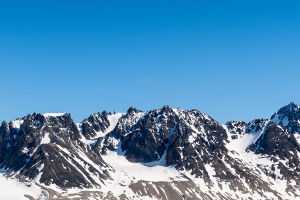Mount Fuji is located in the southern part of Honshu, near Suruga Bay. The mountain has an elevation of 3776.12 meters and is a typical stratovolcano.
A stratovolcano is a conical volcano formed by the continuous accumulation of magma and volcanic debris after several eruptions of almost the same crater. Thus, Mount Fuji was not what we see now from the beginning.
Mount Fuji is a volcano formed from three stages of small Miyake, ancient Fuji, and new Fuji after continuous volcanic eruptions and gradual accumulation of lava from 700,000 years ago.
The last time Mount Fuji erupted was in 1707. The eruption lasted for two weeks and was accompanied by a strong earthquake. After the eruption, the volcanic ash drifted all the way to Edo Castle. Scientific investigations suggest that the current Mount Fuji is still a young active volcano, and its current form is only temporary.
The ridge of Mount Fuji is symmetrical on both sides, resembling an equilateral triangle from a distance. The mountain's shape looks serene and harmonious, and the white snow on the top of the mountain fully reflects its beauty.
As the highest peak in Japan and an active volcano straddling Shizuoka and Yamanashi prefectures, Mount Fuji is known as the "holy mountain" by the Japanese people and is a symbol of the Japanese nation.
As one of Japan's national symbols, it enjoys a high reputation worldwide. It is also often referred to as "Furong Peak," "Fuyue Mountain," or "The Highest Mountain."
Mount Fuji is a cultural symbol of Japan and an inspiration for many works of literature and paintings. Since ancient times, many Japanese people have developed a unique affection and admiration for Mount Fuji.
Many traditional festivals and ceremonies in Japan are associated with Mount Fuji, such as the "Mountain Fuji Climbing" festival, which thousands of people come to climb every year.
The climbing experience of Mount Fuji is unique and unforgettable. Due to the high altitude, climbers need to overcome many challenges, such as altitude sickness and climate change.
Adequate preparations are necessary before climbing, and climbers must pay attention to safety and follow relevant regulations and instructions during the climb. However, once the summit is successful, climbers can enjoy the spectacular scenery and feel the joy and sense of accomplishment of reaching the summit.
In addition to mountaineering, tourists can also travel to hot spring resorts and scenic spots around Mount Fuji. Visitors can enjoy many beautiful views and rich cultural experiences in the area around Mt. Fuji.
For example, tourists can go to the shore of Lake Kawaguchi to see the reflection of Mt. Fuji, or go to the fifth station and the surrounding area of Fuji-Yamaguchi Station to buy souvenirs and special products of Mt. Fuji.
Mount Fuji is a mountain full of charm and mystery. Its unique geographical and cultural background attracts tourists from all over the world to explore it. Although mountaineering requires overcoming certain difficulties and challenges, one can enjoy spectacular views and a sense of accomplishment after successfully reaching the summit.
Furthermore, tourists can also experience the rich culture and history in the area around Mount Fuji, and feel the fusion of Japan's unique tradition and modern civilization. Therefore, Mount Fuji is not only a natural wonder of Japan but also a must-see for tourists from all over the world.


